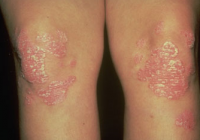Article
Significant Portion of Psoriatic Arthritis Patients Don't Receive Any Treatment
Author(s):
Despite the pervasiveness of psoriasis and psoriatic arthritis, undertreatment and nontreatment of even the most severe forms of those systemic rheumatic diseases are widespread in the United States.

Of the roughly 7.5 million Americans currently suffering from psoriasis, up to an estimated 30 percent are later diagnosed with psoriatic arthritis, a type of arthritic inflammation that causes joint pain, stiffness, swelling, and functional impairment. But despite that pervasiveness, undertreatment and nontreatment of even the most severe forms of those systemic rheumatic diseases are widespread in the United States, according to an analysis funded by the National Psoriasis Foundation (NPF) that was published online on August 14, 2013, in JAMA Dermatology.
Examining data on 5,604 psoriasis and psoriatic arthritis patients collected from 13 national surveys conducted by NPF between 2003 and 2011, April W. Armstrong, MD, MPH, vice chair and director of the Dermatology Clinical Research Unit at the University of California-Davis, along with her colleagues and Mark G. Lebwohl, MD, chair of Mount Sinai Hospital's dermatology department, found that up to 49.2 percent of mild psoriasis patients, up to 35.5 percent of moderate psoriasis patients, and up to 29.7 percent of severe psoriasis patients were not receiving topical, phototherapeutic, oral systemic, or biologic treatment.

Though the researchers discovered that 29.5 percent of moderate psoriasis patients and 21.5 percent of severe psoriasis patients were being treated with topical agents, Armstrong noted in a UC Davis press release that moderate-to-severe psoriasis patients “are often those who require more than just topical treatments to control their psoriasis.” Additionally, roughly half of the psoriasis and psoriatic arthritis patients were dissatisfied with their treatments, which Armstrong suggested “may be due in part to ineffective therapies or patients not understanding that psoriasis and psoriatic arthritis are chronic diseases with symptoms that typically come and go — even during clinical treatment.”
Taking a step towards addressing the widespread lack of prescribed therapies among patients with psoriasis and psoriatic arthritis, the authors emphasized that “efforts in advocacy and education are necessary to ensure that effective treatments are accessible to this patient population.”
“The high proportion of patients who are not being treated or are being inadequately treated is a concern because psoriasis is much more than a cosmetic skin condition,” Armstrong said. “It’s a serious and chronic medical disease.”




